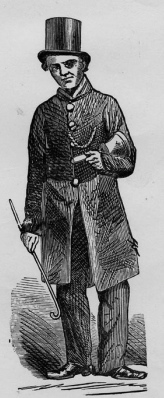Related Research Articles
"Blaydon Races" is a Geordie folk song of 1862, with lyrics by George Ridley written in a style deriving from music hall. It celebrates the horse races held at Blaydon in North East England that year, although mostly composed in advance of the event. The words were inspired by the American ballad "On the Road to Brighton", to the tune of which they are set. The song has become a local anthem, and is frequently sung by supporters of Newcastle United Football Club, Newcastle Falcons rugby club, and Durham County Cricket Club.

George "Geordie" Ridley (1835–1864) was a Tyneside concert hall songwriter and performer in the middle of the 19th century. His most famous song is "Blaydon Races". He was a contemporary of Edward Corvan. He has been described by a council source as a candidate for Tyneside's most famous songwriter.
Joe Wilson was a Tyneside concert hall songwriter and performer in the mid-19th century. His most famous song is "Keep yor feet still Geordie hinny". He was a contemporary of George "Geordie" Ridley. He wrote and sang in the Geordie dialect of Newcastle upon Tyne, his native speech.
"The Caller" is a Geordie folk song written in the 19th century by Edward “Ned” Corvan, in a style deriving from music hall.
Thomas Allan was an English collector of songs and a music publisher from Newcastle upon Tyne who played a major part in the recording of the music of the day.
James Horsley (1828–1891) was an Alnwick born songwriter, editor, and general handyman. In addition to his songs, he wrote many pieces of poetry about Jesmond. The most well-known of the songs may well have been "'She's sumboddy's bairn".
T. Moor was a Tyneside singer/songwriter of the 19th century. The only song attributed to his name is "The Skipper's Dream".
John Peacock was a South Shields born songwriter and poet in the 19th century. His most famous piece is possibly "Marsden Rocks".
Joshua L Bagnall was a Tyneside composer of the early and mid-19th century.
John Morrison was a Tyneside songwriter from the early nineteenth century.

Balmbra's Music Hall was an early Music Hall in the centre of Newcastle, England, in the middle of the 19th century.
Metcalf Ross was an English master printer and sometime poet/songwriter in Tyneside. He was born in Sunderland, Tyne and Wear.

Allan's Illustrated Edition of Tyneside Songs and Readings... is an historic book of Tyneside popular and traditional songs that consisted, in its final published form, of a compilation of approximately 400 song lyrics and notes, with added songwriter and subject biographies and geographical details, together spanning over 600 pages. It was reprinted in 1972 by Frank Graham, Newcastle upon Tyne, with an introduction by music scholar David Harker.
William Watson (1796–1840) was a Tyneside concert hall singer and songwriter in the early 19th century. His most famous song is "Dance To Thy Daddy".
John Stokoe was a 19th-century Tyneside author and historian. He co-operated with the author John Collingwood Bruce in compiling the hugely important “Northumbrian Minstrelsy” published in 1882.
Ralph John Wilkinson was an English bookseller from Newcastle active in the late 19th and early 20th century. and songwriter, with premises in the Market.
Thomas Kerr was a Tyneside writer, journalist and songwriter of the middle and late 19th century.
George Guthrie moved away from the town eastwards towards the coast, and worked as a blacksmith in Wallsend and Sunderland.
John William Chater (1840–1885) was a prominent 19th-century Tyneside publisher, printer and bookseller, with premises in the centre of Newcastle.
John Higgins was a town crier in Newcastle upon Tyne in the 19th century.
References
- ↑ Allan's Illustrated Edition of Tyneside songs and readings with lives, portraits and autographs of the writers, and notes on the songs. Revised Edition. Thomas & Gorge Allan, 18 Blackett Street, and 34 Collingwood Street, (Newcastle upon Tyne) – Sold by W. Allan, 80 Grainqer Street, Newcastle upon Tyne, B. Allan, North Shields and Walter Scott. London. 1891.
- (Booklet) The Hall That Outlived Them All by Cindy Lightburn. (Amazon)
- (Booklet) BALMBRA'S: A Nostalgic Revisit by Cindy Lightburn. (Amazon)